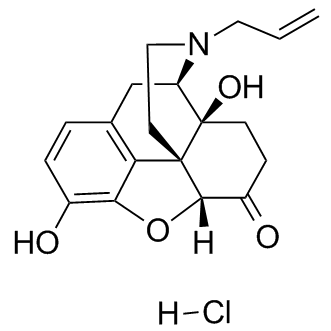All AbMole products are for research use only, cannot be used for human consumption.

Naloxone hydrochloride is an opioid inverse agonist compound used to counter the effects of opiate overdose.
| Cell Experiment | |
|---|---|
| Cell lines | BV‐2 cells |
| Preparation method | The phagocytic activity of BV‐2 cells was measured by Vybrant phagocytosis assay kit according to the manufacturer's instructions. Briefly, BV‐2 cells were treated with LPS (200 ng·mL−1) and (+)‐naltrexone/(+)‐naloxone for 24 h. |
| Concentrations | 20 μM |
| Incubation time | 24 h |
| Animal Experiment | |
|---|---|
| Animal models | adult male C57BL/6J-Bom mice |
| Formulation | saline |
| Dosages | 0.01, 0.1, or 1 mg/kg |
| Administration | s.c. |
| Molecular Weight | 363.84 |
| Formula | C19H21NO4.HCl |
| CAS Number | 357-08-4 |
| Solubility (25°C) | DMSO 50 mg/mL Water 50 mg/mL |
| Storage |
Powder -20°C 3 years ; 4°C 2 years In solvent -80°C 6 months ; -20°C 1 month |
| Related Opioid Receptor Products |
|---|
| SNC162
SNC162 is a delta-opioid receptor agonist with an IC50 of 0.94 nM. |
| ML 190
ML 190 is a selective κ opioid receptor (KOR) antagonist with an IC50 of 120 nM and an EC50 of 129 nM, respectively. |
| CCG258747
CCG258747 is a selective GRK2 inhibitor (IC50=18 nM) with high selectivity over GRK1, GRK5, PKA, and ROCK1 (518, 83, >5500, and >550–fold, respectively).CCG258747 also blocks the internalization of the µ-opioid receptor. |
| Sunobinop
Sunobinop (S 117957) is a modulator of the opioid receptor-like orphan receptor (ORL1). |
| SCH 486757
SCH 486757 is an orally effective pain peptide receptor (NOP) agonist. |
All AbMole products are for research use only, cannot be used for human consumption or veterinary use. We do not provide products or services to individuals. Please comply with the intended use and do not use AbMole products for any other purpose.


Products are for research use only. Not for human use. We do not sell to patients.
© Copyright 2010-2024 AbMole BioScience. All Rights Reserved.
